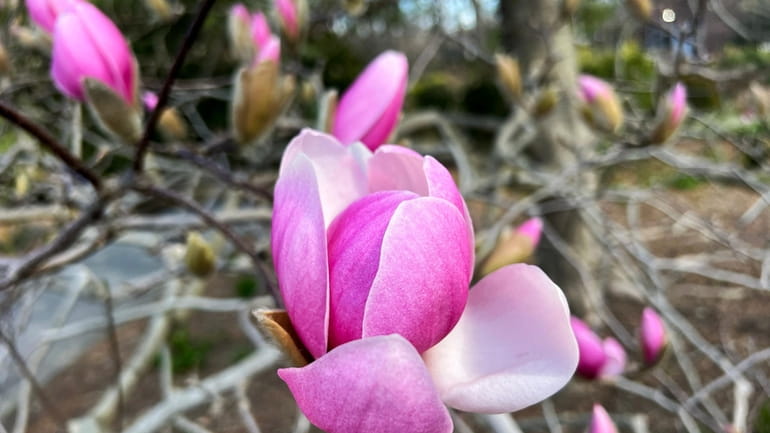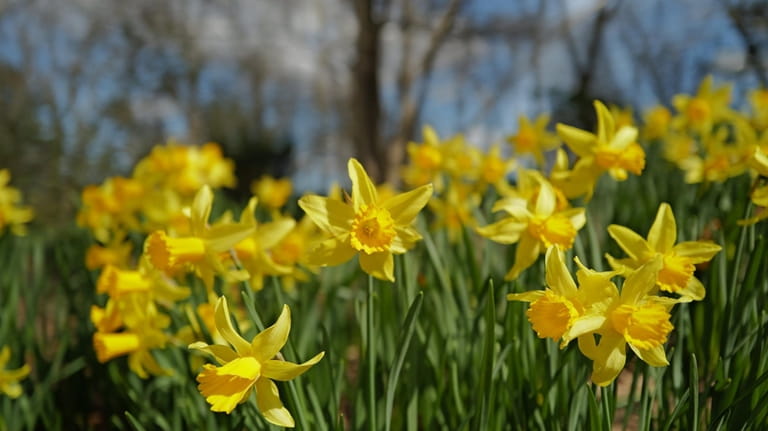Why is spring coming early this year? Answering your questions about the arrival of the vernal equinox

Flowers in bloom in Clark Botanic Garden in Albertson on Monday. Credit: Debbie Egan-Chin
While temperatures have been unusually warm for weeks, spring — the astronomical version it — officially arrives Tuesday.
After a mild winter, parts of Long Island are experiencing the warmest March on record, according to the National Weather Service, with temperatures about 10 degrees warmer than normal. Across the country, those warming days are bringing out leaves and buds, sometimes well ahead of schedule. That can mean a longer growing season but also a longer allergy season and more time for insects like ticks to multiply.
When exactly does spring start?
Astronomical spring in the Northern Hemisphere begins with the vernal equinox, which will occur at 11:06 p.m. Tuesday. At this moment, the National Weather Service explains, the earth’s axis will be tilted neither toward nor away from the sun, which will appear exactly over the equator. As a result, there will be a nearly equal amount of daylight and darkness at all latitudes. For those of us in the northern hemisphere, each coming day will bring more sun and longer days. The opposite is true for those in the southern hemisphere.
In recent years, the equinox has been on March 20. It'll be back on March 20 again next year, with a return to March 19 on leap years in the immediate future.
But spring is also marked by temperature cycles. Meteorological spring started March 1 and will run through June 1. Between 1896 and 2022, according to the federal Environmental Protection Agency, average spring temperatures across the contiguous 48 states have increased by about 2 degrees Fahrenheit.
The warming trend is changing the world around us. In recent years, the final spring frost has occurred earlier than at any point since 1895, according to the EPA.
According to the USA National Phenology Network, a research consortium that tracks seasonal biological markers, some common early spring shrubs and other plants will sprout leaves about two weeks earlier this year across much of Long Island.
What happened to winter's bite?
Across much of the United States, winter had little bite this year.
“Long-term warming combined with El Niño conspired to make winter not show up in the U.S. this year,” said Yale Climate Connections meteorologist Jeff Masters, who cofounded the private firm Weather Underground, referring to the El Niño global weather pattern.
On Friday, the National Oceanic and Atmospheric Administration confirmed that the winter of 2023-2024 was the warmest in nearly 130 years of record-keeping for the United States. The lower 48 states averaged 37.6 degrees, which is 5.4 degrees above average.
This is just the latest in a drumbeat of broken temperature records, national and global, that scientists say is mostly from human-caused climate change from the burning of coal, oil and gas.
And it was the warmest U.S. winter by a wide margin. The past three months were 0.82 degrees warmer than the previous record set eight years ago, which “is a pretty good leap above the previous record,” said Karin Gleason, chief of monitoring at NOAA's National Centers for Environmental Information.
What does this mean for Long Island gardeners and farmers?
Warmer weather can cause trees and flowers to bloom early.

Flowers blooming in Clark Botanic Garden in Albertson on Monday. Credit: Debbie Egan-Chin
At Hicks Nursery in Westbury, marketing associate Karen Musgrave said spring bulbs were coming up, but “nothing’s happening any sooner than normal.”
Musgrave said “The forsythia is starting to bloom yellow, the hyacinth is coming in lavender and beautiful purple, and it’s starting to happen now — some of the flowering trees, like flowering cherry trees, weeping cherry trees and flowering plum trees” are starting to show color.
A run of warm weather last week drove attendance at the nursery’s flower show, she said. “People are ready to go outside and start planting.”
While warmer springs have helped extend growing seasons across New York and most of the country, most farmers on Long Island are cautious about planting early because a temperature dip could cost them their crop, said Long Island Farm Bureau director Robert Carpenter. “There are fragile lettuces that can’t take any cold, and any type of squash, if it freezes, you’re going to lose that crop … We always tell people, don’t put it into the ground until the fear of frost is over, just because of a couple warm days in March.”
With AP
Correction: The spring equinox has been on March 20 in recent years and will be back on March 20 again next year. In the immediate future, it will return to March 19 on leap years. An earlier version of this story inaccurately described its timing.
